|
Today in New Orleans History |
|
|
March 9


 Much
discussion ensued. On July 12, 1955, Morrison said "We assured the Jazz Foundation [New Orleans Jazz
Club] a few months ago [at the lighting ceremony] there would be a monument to jazz on the street and it is a definite plan
of the city". L.A. Riley wrote, and his letter was published in the paper on July
17, 1955. He recounted personal memories of Milneburg's long pier stretching from the original shore to the lighthouse
with its walkways to many camps and clubhouses where jazz parties were "all conducted by very respectable people. He
contended that while jazz was played on Basin Street it was born in Milneburg and that that Milenburg Joys (not Basin Street
Blues) should be the "New Orleans anthem". Riley suggested that a monument to jazz placed, not on Basin Street but
"where Milneburg once stood at Pontchartrain Beach between the lighthouse and former shoreline. The same day Riley's
letter appeared so did one from Blanchin which stated that the non-profit New Orleans Jazz Club, formed in 1948, supported
Morrison's Basin Street monument site. On July 21, 1955, the editor of the Picayune
opined that a panel of jazz historians could best choose the location and wording for a monument and ended with "Take
it easy", regarding the furor the issue had caused. The following day, William Dane's letter appeared (on July
22, 1955) suggesting that, instead of Bolivar, the statue of assassinated police chief David Hennessy should be
transplanted from Metairie Cemetery. August 1, 1955 brought a letter from J.F.O. who claimed he had played music for 35 years,
thought a monument to jazz was a good idea, and stated "I never heard of Simon Bolivar", which was likely the sentiment
of many other New Orleanians.  

To receive an update for each day in New Orleans
history, join our facebook page
- Today in New Orleans History
"When I wrote and recorded 'Lawdy Miss Clawdy' back in 1952, it marked the birth of rock 'n'
roll," said Price, who was inducted into the Rock And Roll Hall Of Fame in 1998. "That song sold millions, and
it was the introduction of music as we know it today." Lloyd Price in an interview with Bill Herald of Examiner.com.
Born one of 11 children of Louis and Beatrice Price in Kenner on March 9, 1933, Lloyd Price had formal musical
training in trumpet and piano, sang in his church's gospel choir, and was a member of a combo in high school. On
March 9, 2010, his 77th Birthday, in New Orleans, Lloyd Price was inducted into The Louisiana Music Hall of Fame
and on June 20, 2010, Price appeared and sang in season 1 finale of the HBO series "Treme". Price currently manages
Icon Food Brands, which makes a line of primarily Southern-style foods, including Lawdy Miss Clawdy food products, ranging
from canned greens to sweet potato cookies, and a line of Lloyd Price foods, such as Lloyd Price's Soulful 'n' Smooth Grits
and Lloyd Price's Energy-2-Eat Bar (with the brand slogan "Good taste ... Great Personality"), plus Lawdy Miss
Clawdy clothing and collectibles. Lloyd Price Avenue in Kenner was named for the singer in 2007 and the city celebrates
an annual Lloyd Price Day.
Joseph Francis Rummel, born on October 14, 1876 in Steinmauern, Baden, was bishop of the Diocese
of Omaha, Nebraska (Mar. 30, 1928 - Mar. 9, 1935) and Archbishop of the Archdiocese of New Orleans (March 9,
1935 - November 8, 1964). By October 1962, Rummel was eighty-six years old, in declining health, and almost
completely blind from glaucoma. Nevertheless, he left New Orleans for Vatican City to attend the first session of the Second
Vatican Council. Archbishop Joseph Rummel died in New Orleans on November 9, 1964, at the age of eighty-eight. He was
succeeded by John Cody, the Coadjutor Archbishop (1961–1964). Archbishop Rummel is interred under the sanctuary at Saint
Louis Cathedral in the French Quarter. Archbishop Rummel was the Archbishop of New Orleans for twenty-nine years, through
a world war, and the beginning of the Civil Rights era. His Youth Progress Program had a profound impact on education in
the city of New Orleans. and his leadership ended racial segregation in the churches and the schools of the Archdiocese.Archbishop
Rummel High School in Metairie is named after him.
James Mather (c. 1750 in England – 1821 in St. James Parish, Louisiana) was mayor of New
Orleans from March 9, 1807 to October 8, 1812. His place of birth is variously given as Coupland
in Northumberland; or London. A merchant by trade, he moved to America in 1776, and by 1780 he was working in New Orleans,
contracting with the Spanish Government to operate two vessels out of the port and importing articles required in the trade
with the Indians of Louisiana and West Florida. Mather & his descendents owned a large sugar plantation in Lutcher, Louisiana
until 1879. He was appointed mayor of New Orleans by William C.C. Claiborne, governor of the Louisiana Territory. Almost
as soon as became mayor, he was obliged to take measures to defend the city against the possibility of a conspiracy by the
friends of Aaron Burr, which, however, did not eventuate. In November 1809, through similar measures, he is credited with
averting an insurrection of the black population. Mather attempted to establish a viable police force for the city, but
failed. He succeeded, however, in creating a tolerably efficient fire department. The last years of his administration saw
him under fire for being under the influence of certain individuals, for failing to protect the city's interests by vetoing
the resolutions of the city council, and for hiring people to write anonymous letters attacking his enemies and paying them
with public funds: whether any of this was true has proved impossible to determine. In 1812, however, he had had enough,
and resigned. He retired to his son's property on the Acadian Coast of Louisiana, where he died in 1821. A transfer ceremony for the Louisiana Purchase was held in New Orleans on November 29, 1803. Since
the Louisiana territory had never officially been turned over to the French, the Spanish took down their flag, and the French
raised theirs. The following day, General James Wilkinson accepted possession of New Orleans for the United States. A similar
ceremony was held in St. Louis on March 9, 1804, when a French tricolor was raised near the river, replacing
the Spanish national flag. The following day, Captain Amos Stoddard of the First U.S. Artillery marched his troops into town
and had the American flag run up the fort's flagpole. The Louisiana territory was officially transferred to the United States
government, represented by Meriwether Lewis. The Louisiana Territory, purchased for less than 3 cents an acre, doubled the
size of the United States overnight, without a war or the loss of a single American life, and set a precedent for the purchase
of territory. It opened the way for the eventual expansion of the United States across the continent to the Pacific.
|
|
|

To receive an update for each day in New Orleans history,
join our facebook page - Today in New
Orleans History.
Analytics |
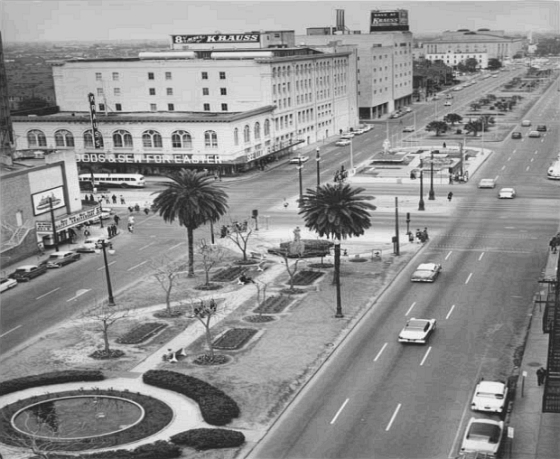
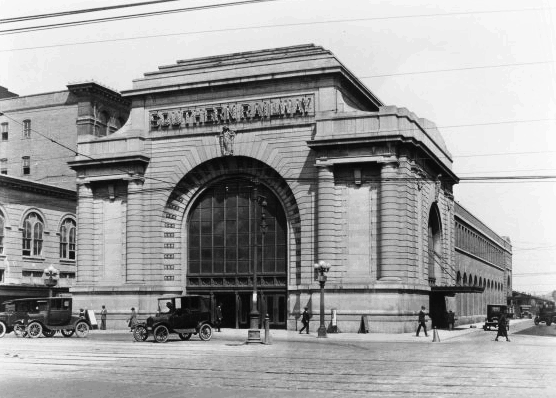 Mayor deLesseps S. Morrison's vision for New Orleans was one of a modernistic 'progressive' hub of business activity.
He saw other cities grow by leaps and bounds after tearing down the old and bringing in the new and he envisioned the same
for our town. Morrison's administration changed the footprint of New Orleans irrevocably. One example was the demolition
of the Southern Railroad Terminal, also known as the Terminal Station, which was constructed at 1125 Canal at Basin Street
in 1908. The building was designed by Daniel Burnham, the architect for Washington D.C.'s Union Station.
Mayor deLesseps S. Morrison's vision for New Orleans was one of a modernistic 'progressive' hub of business activity.
He saw other cities grow by leaps and bounds after tearing down the old and bringing in the new and he envisioned the same
for our town. Morrison's administration changed the footprint of New Orleans irrevocably. One example was the demolition
of the Southern Railroad Terminal, also known as the Terminal Station, which was constructed at 1125 Canal at Basin Street
in 1908. The building was designed by Daniel Burnham, the architect for Washington D.C.'s Union Station. 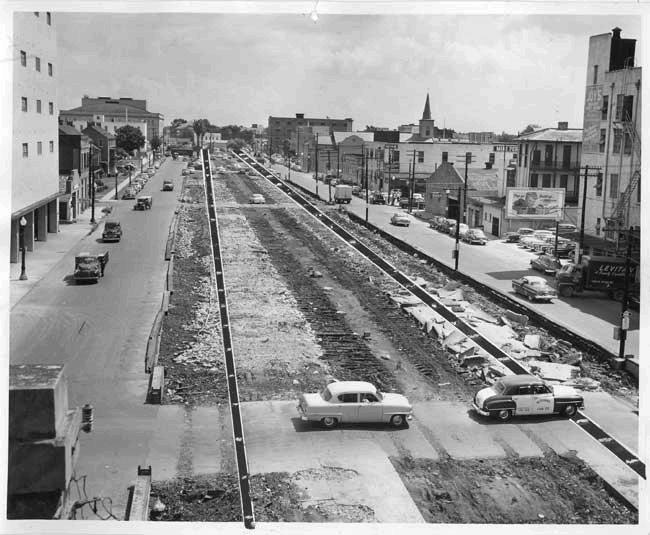
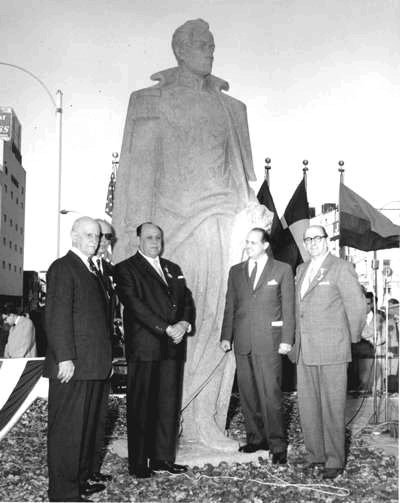
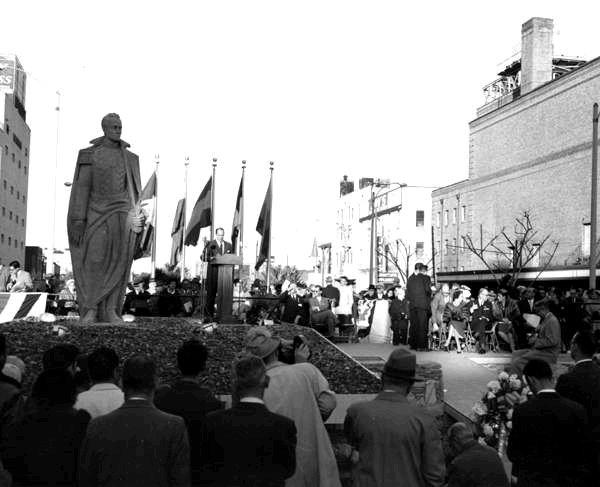 Despite the hoopla, the name for Basin Street's neutral ground as "Garden of the Americas" was officially adopted
via a city ordinance on April 14, 1957. On Monday, May 6, 1957, a "Parade of Progress" ambled 22
blocks from the Municipal Auditorium to Basin Street at Canal where ground was broken for the plaza that would contain Simon
Bolivar's giant likeness. The Tulane band played for guests from South and Central America. The first shovel of dirt
was turned by Francisco Pacanins, Consul General of Venezuela, whose country provided $350.00 for the monument. The
parade then proceeded to the New City Hall which officially opened that day. And finally, on Monday November 25, 1957,
the seven-ton, 12 foot-tall, granite statue of Simon Bolivar was unveiled. on the Basin Street neutral ground.
Despite the hoopla, the name for Basin Street's neutral ground as "Garden of the Americas" was officially adopted
via a city ordinance on April 14, 1957. On Monday, May 6, 1957, a "Parade of Progress" ambled 22
blocks from the Municipal Auditorium to Basin Street at Canal where ground was broken for the plaza that would contain Simon
Bolivar's giant likeness. The Tulane band played for guests from South and Central America. The first shovel of dirt
was turned by Francisco Pacanins, Consul General of Venezuela, whose country provided $350.00 for the monument. The
parade then proceeded to the New City Hall which officially opened that day. And finally, on Monday November 25, 1957,
the seven-ton, 12 foot-tall, granite statue of Simon Bolivar was unveiled. on the Basin Street neutral ground. 
